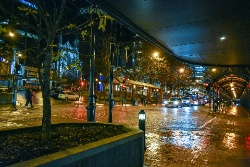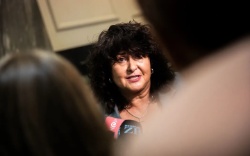Rena Recovery Newsletter - Issue 12
Rena Recovery Newsletter - Issue 12
This issue includes:
• Results from the biosecurity
survey
• Update on monitoring findings
• Professor
Chris Battershill shares his 'lessons from Rena'
•
Information about the sampling protocol
• An update on
shoreline oil
• News on salvage
work
Biosecurity surveys shows no
foreign species
Recent biosecurity
survey work, undertaken by NIWA, has confirmed there are no
signs of foreign species in the area.
Sea
Tow 60 is a barge that was brought to New Zealand from
Australia to help with the Rena response in October 2011.
Because the barge was brought into the country under urgent
conditions, the hull was not cleaned properly and concerns
were raised that foreign organisms from the barge may have
become established in New Zealand waters. However recent
biosecurity survey work has confirmed there are no signs of
foreign species in the area.
In January 2013, NIWA, contracted through the Rena Recovery programme, completed a survey of Tauranga Harbour. More than 290 samples were collected, but none of these contained foreign species from the barge.
NIWA and students from Te Mauri Moana Tertiary Partnership went back into the mangrove forests in Tauranga Harbour in March 2013 to do a second trapping survey for crabs found on the Sea Tow 60. They captured more than 2400 crabs in pitfall traps (small, buried traps that the crabs fall into while scuttling around) but all of the crabs were found to be native species, and they were released back into the mangroves.
During April and May, the NIWA team
examined sites at Otaiti (Astrolabe Reef) and Motiti Island.
Divers searched six sites around Motiti where the barge had
been moored or working.
A shore-based team that included
members of the Motiti community also surveyed a further six
intertidal sites. At Otaiti, dive teams surveyed transects
at three locations distributed around the edge of the wreck
site. Again, the survey showed there was no sign of any of
the foreign species.
Lessons from Rena
A Q+A with Professor Chris Battershill,
Chair, Coastal Science, Environmental Research Institute,
University of Waikato
How long have you
been undertaking monitoring work on the Rena for
now?
Since 5 October 2011. Basically we started
the morning the ship hit the reef. The first tasks were to
check what we knew about the reef and the other reef systems
out there, then what we knew of the beaches and what was
known of the estuaries and sensitive areas. We discussed the
grounding with the iwi cultural fisheries leaders and then
started to plan how to fill in the knowledge gaps.
The
information that we were able to collect is now invaluable
in allowing the return to 'normality' to be
tracked.
What’s been the most interesting thing
about your work?
Finding out a huge amount about
how Heavy Fuel Oil interacts with the environment. Prior to
the work of our team nothing was known of how HFO interacted
with the environment.
Now we have one of the most
comprehensive sets of information that is relevant to New
Zealand and also relevant to real life situations. The work
spans everything from the chemistry of the oil and how its
age in the sea can be determined, and to how bugs eat it in
sand, how kaimoana take it up and then get rid of it again.
None of this information was known before.
In
terms of science, have there been any big breakthroughs for
you and your team?
Yes; what’s been a big
learning point for us is the understanding from the chemical
level to the whole of an ecosystem level just how oil and
other contaminants interact and are degraded naturally. This
is the first time this type of truly integrated work has
focused on a marine disaster as well.
Secondly, the
work is carried out by many parties, yet it is all
coordinated and also, uniquely, it’s spliced intimately
with Matauranga Maori. All these elements are
firsts.
What have the highlights been for
you?
Speaking with the public in the early days
at the many meeting rooms and marae around the region. This
was challenging as everyone was obviously upset about the
incident. What I saw however was a genuine desire to learn
the facts. People wanted cold hard facts about the situation
and realistic predictions.
I found that the community
rose with the level of information that was being generated.
We now have a well-informed public who have followed this
through from day one.
The other highlight was working
with such a diverse team and sharing the excitement when we
started to see natural reduction of oil tainting in
kaimoana. It was fast and unexpected and sent real hope
through to the communities that their environment could
recover from this.
What's your involvement in
future?
We are here for the very long haul. The
students who started as volunteers or summer school scholars
on Rena Recovery work are still with us and are tracking
very well indeed to higher degrees and careers in marine and
environmental science. They have cut their teeth on one of
the world’s most complex marine disasters. They will be in
high demand.
Through the efforts of the Te Mauri Moana
partnership, there is now a swell of multi-disciplinary
research capacity that we want to build on for new courses
and research and training opportunities. This is of great
relevance to the region and nation, and it’s clear that
international attention has been paid to this as the
response is now benchmarking how one might deal with other
marine disasters anywhere in the
world.
Rena fore section wreck reduction
completed
Resolve Salvage and Fire
completed its primary contract to reduce the fore section of
the Rena wreck on Saturday 29 June 2013.
The
total fore section steel recovered is now at 1261.93 tonnes.
An underwater reef survey will now be completed to verify
the remaining hull structure is below Lowest Astronomical
Tide, minus 1 metre.
An announcement was made on 28 June by the Rena owners and insurers to remove the accommodation block from the wreck. Concerns had been raised by communities within the Bay of Plenty and by Bay of Plenty Regional Council about the possibility of the accommodation block degrading or collapsing in the future, releasing debris that could wash up on the shoreline.
Resolve Salvage and Fire will remove the accommodation block in two sections using an oblique chain cutting parallel to the main deck. The operation is expected to take up to 80 days. Cutting is expected to begin in October following the arrival of an additional crane barge from Singapore.
Update on monitoring
Monitoring results from the research
undertaken by the Rena Recovery monitoring programme will be
completed and available to the public by early August.
The monitoring programme is the largest piece of work that has been carried out under the Rena Recovery Long Term Environmental Recovery Plan. The aim of the monitoring programme is to assess long-term environmental effects of the Rena grounding and monitor recovery. A focus of the programme has been to assess kaimoana species and their marine habitats. Surveys and sampling have been done to check if there have been any noticeable ecological changes, and if important seafood species have been affected. Surveys have been undertaken in areas most heavily affected by oil and those of cultural significance to iwi.
The monitoring work has been undertaken by Te Mauri Moana - a collaborative group of tertiary education organisations.
Rena Recovery Manager Bruce Fraser says: “This research will provide a clear snapshot of the state of the coastal environment and its progress towards recovery. The overall goal of the Rena Recovery plan is to restore the mauri of the affected environment to its pre-Rena state. This body of work will allow us to assess the situation and identify what further work needs to be done.”
Sampling protocol
agreed
A comprehensive and independent
scientific testing protocol has been established and will be
used to measure the health of the marine environment around
Astrolabe Reef and Motiti Island.
Rena Recovery Group scientists from the University of Waikato and Bay of Plenty Polytechnic are undertaking a significant sampling programme, following collaboration to develop a rigorous independent protocol between tertiary institutions, Bay of Plenty Regional Council, the Ministry of Primary Industry and representatives of the Rena’s owner and insurer, including the scientific research companies Cawthron Institute and Bioresearches.
Samples will be taken from 12 sites on Astrolabe and 28 sites around the reef at distances of 500m, 1000m and 1500m from the wreck. The samples will include sediment, sea urchins, rock lobster, sea snails, bivalve molluscs and resident fish species such as sea perch, scorpion fish and blue cod. Three hull paint samples will also be taken from the wreck itself, and a one-off sampling of the underlying reef structure.
At the northern end of Motiti Island, samples of fish, invertebrates and sediment will be collected from two sites. Samples from two stations 500m offshore and two sites 1000m offshore will also be collected.
Control samples of sediment, invertebrates, fish and rock lobster will be taken from 12 sites at Tuhua (Mayor Island) and Rurima islands to provide a basis for comparison.
Sample analysis will be carried out by RJ Hill Laboratories.
The sampling programme will provide comprehensive data from which to accurately measure the health of the marine environment, the impact of the Rena grounding and the recovery of affected areas.
Oil Update
There have
been a small number of reports of people finding oil on
their feet after spending time at the beach. It is expected
that from time to time very small drops of oil will continue
to appear in areas that were most heavily affected by the
Rena oil spill.
The only area with reports of oil spots has been in the shallow water where the waves are rolling in, this area is also known as the wash zone. The wash zone plays an important part in the environment’s natural cleaning process where large swells cause oil to resurface and wave action breaks down the oil.
While oil contains PAHs - Polycyclic Aromatic Hydrocarbons - which can be toxic, the ocean contains bacteria that break down the structure of oil into less complex substances that are less hazardous. This process happens over time and through wave action along the shoreline and rocky shore.
Shoreline monitoring and feedback from the public have not highlighted any oil appearing above the tide line on the dry sand for many months.
If you do come across any significant amount of oil on the beach remember to notify the Bay of Plenty Regional Pollution Hotline on 0800 884 883.
ENDS


 Gordon Campbell: On The Hamas Ceasefire Offer, And Mark Mitchell’s Incompetence
Gordon Campbell: On The Hamas Ceasefire Offer, And Mark Mitchell’s Incompetence Wellington Office of the Mayor: Mayor Responds To Housing Minister’s District Plan Decision
Wellington Office of the Mayor: Mayor Responds To Housing Minister’s District Plan Decision Stats NZ: Have Your Say On Modernising The Census
Stats NZ: Have Your Say On Modernising The Census NZ Government: Therapeutic Products Act To Be Repealed
NZ Government: Therapeutic Products Act To Be Repealed The Treasury: Interim Financial Statements Of The Government For Nine Months Ended 31-3-2024
The Treasury: Interim Financial Statements Of The Government For Nine Months Ended 31-3-2024  Government: New Zealand Sign Language Week An Opportunity For Anyone To Sign
Government: New Zealand Sign Language Week An Opportunity For Anyone To Sign ACT New Zealand: Investment In Prisons Delivers On ACT Commitment
ACT New Zealand: Investment In Prisons Delivers On ACT Commitment


